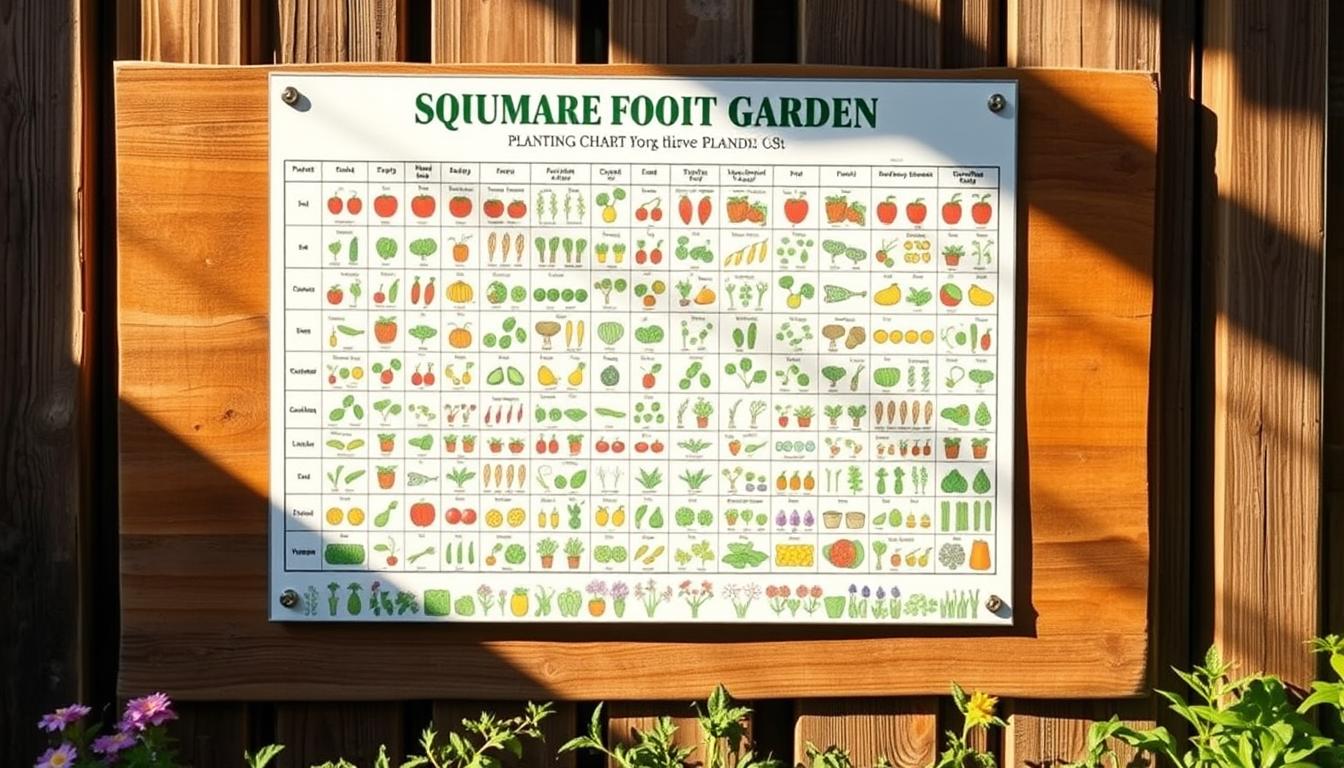Are you looking for a smarter way to grow your favorite vegetables? The square foot gardening method is here to help. This innovative approach maximizes space, making it perfect for small areas or beginners. With a simple planting chart, you can easily decide how to arrange your plants for the best results.
This method, introduced by Mel Bartholomew in 1976, has revolutionized how people think about gardening. It focuses on efficiency, reducing maintenance, and increasing yields. By dividing your space into small sections, you can grow more in less room. It’s a time-saving alternative to traditional row gardening.
Whether you’re new to gardening or an experienced grower, this method simplifies the process. A planting chart ensures proper spacing, helping your plants thrive. Ready to get started? Let’s dive into a step-by-step guide to planning your garden with this effective technique.
Key Takeaways
- Maximize space with the square foot gardening method.
- Enjoy higher yields and reduced maintenance.
- Use a planting chart for efficient plant spacing.
- Ideal for small spaces and beginner gardeners.
- Save time compared to traditional row gardening.
What is Square Foot Gardening?
Discover a revolutionary way to grow more in less space. Square foot gardening is an intensive planting method that uses a grid system to maximize efficiency. Developed by Mel Bartholomew in 1976, this approach was designed as a smarter alternative to traditional row planting.
The core principle is simple: “Plant by area, not by rows.” Instead of spacing plants in long rows, you divide your growing area into small, manageable squares. A typical bed measures 4×4 feet and contains 16 individual squares, each 1×1 foot in size.
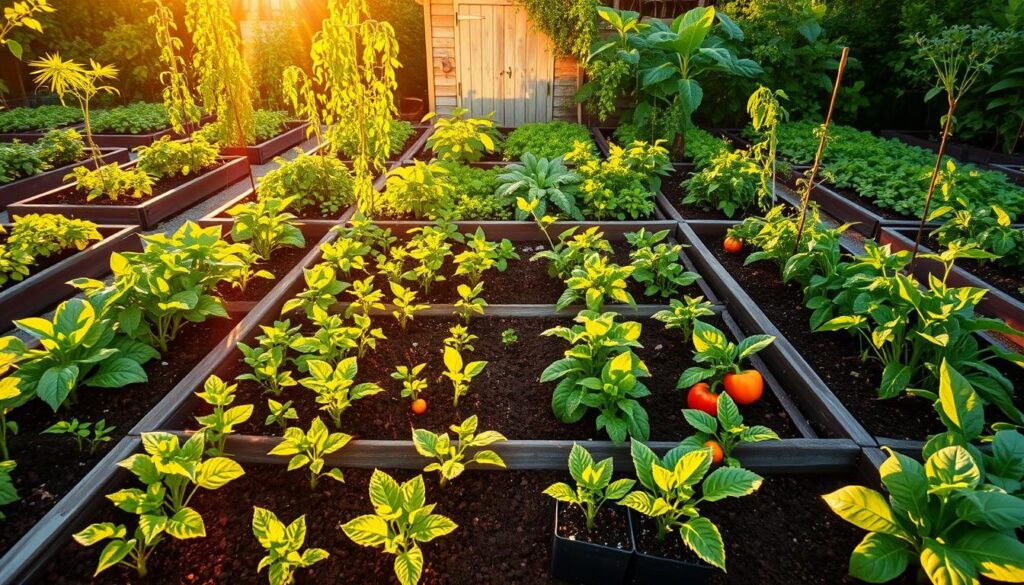
This method eliminates wasted space and ensures every inch of your garden is productive. It’s also designed with convenience in mind. The 2-foot arm span concept means you can easily reach any part of the bed without stepping on the soil. Permanent walking paths between beds further protect your plants and make maintenance a breeze.
Compared to traditional gardening, square foot gardening offers several advantages. It reduces the need for weeding, conserves water, and allows you to grow a variety of plants in a compact area. Whether you’re a beginner or an experienced gardener, this method simplifies the process and boosts your harvest.
Ready to learn more? Check out our guide on how to start a garden for additional tips and insights.
Benefits of Square Foot Gardening
Transform your gardening experience with the efficiency of square foot gardening. This method maximizes small areas, making it ideal for urban settings or limited space. With 80-90% space efficiency, you can grow more in less room.
One of the standout advantages is reduced maintenance. This approach cuts weeding and watering by 50%, saving you time and effort. The strategic bed design also minimizes soil compaction, ensuring healthier roots for your plants.
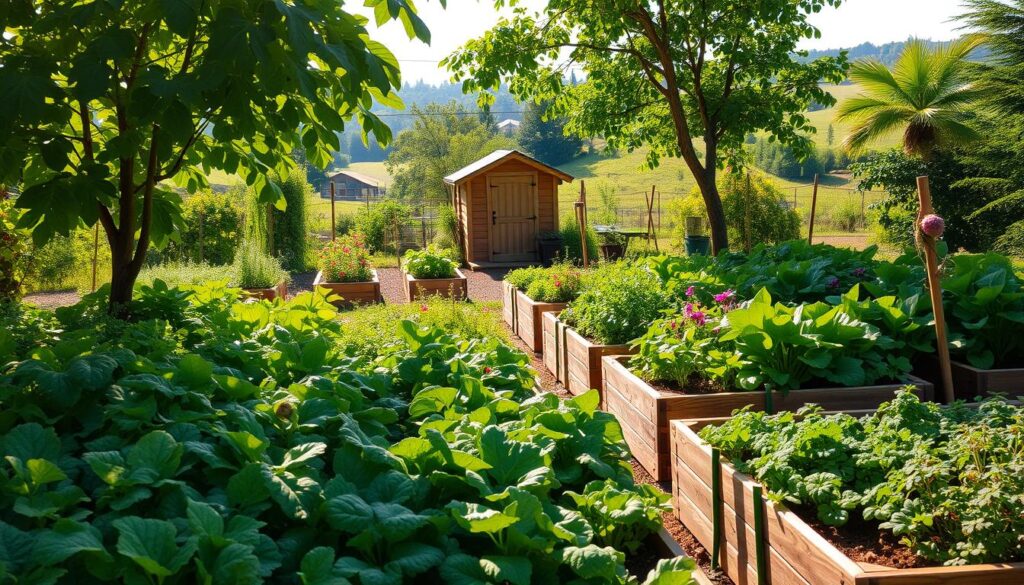
Water conservation is another key benefit. By focusing on smaller areas, you use resources more effectively. Plus, the diversity of plants in each bed helps manage pests naturally, reducing the need for chemicals.
For those with mobility challenges, this method is highly accessible. The compact design allows you to reach every part of the bed without stepping on the soil. Adding cold frames can even extend your growing season, giving you fresh vegetables year-round.
In summary, square foot gardening offers:
- Higher yields in less space
- Simplified maintenance and water conservation
- Improved accessibility for all gardeners
- Natural pest management through plant diversity
- Seasonal extension with cold frames
How to Start a Square Foot Garden
Ready to create a thriving, organized growing area? Starting a structured growing system is simple and rewarding. With a few steps, you can build a productive setup that maximizes your space and yields impressive results.
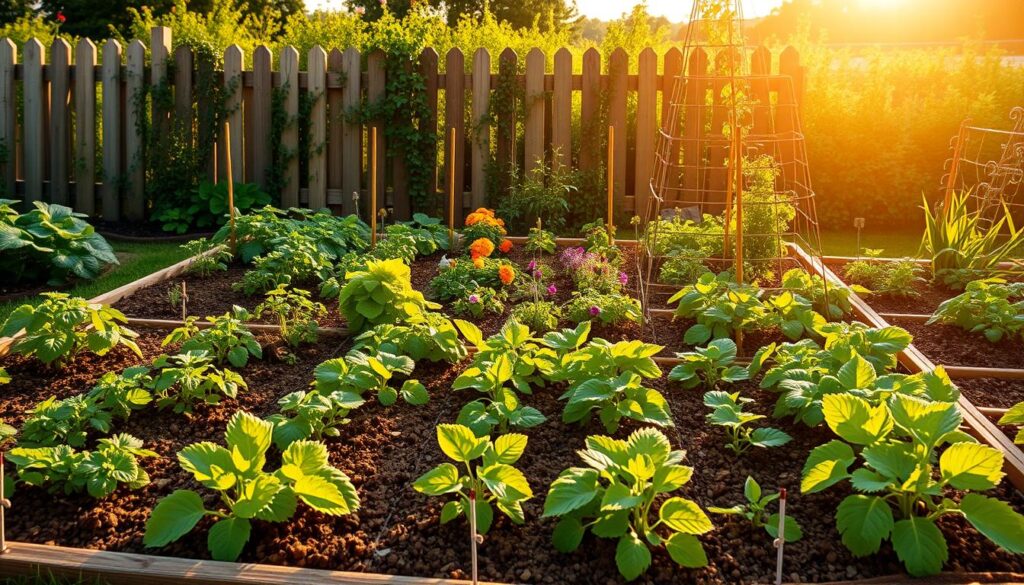
Choosing the Right Location
Selecting the perfect spot is crucial for success. Look for an area that gets 6-8 hours of sunlight daily. Sunlight is essential for healthy growth and high yields.
Consider wind protection as well. Strong winds can damage plants or dry out the soil. A sheltered location or a simple barrier can make a big difference.
Building Your Garden Bed
Once you’ve chosen the location, it’s time to build your garden bed. The ideal width is 4 feet or less, ensuring you can reach the center easily. Use untreated cedar or redwood for durability and safety.
Depth matters too. Aim for at least 6 inches of soil, or 12 inches for root vegetables. This ensures your plants have enough room to grow strong roots.
For the soil mixture, combine equal parts compost, peat moss, and vermiculite. This blend provides nutrients, retains moisture, and promotes healthy growth.
If you’re on a budget, consider DIY options or fabric beds. These alternatives are cost-effective and work just as well as commercial raised beds.
Creating Your Square Foot Garden Layout
Designing your growing space can be both fun and rewarding. A well-thought-out layout ensures every inch of your area is used efficiently. Start by dividing your 4×4 bed into a 16-cell grid. This structure helps you organize your plants and maximize productivity.
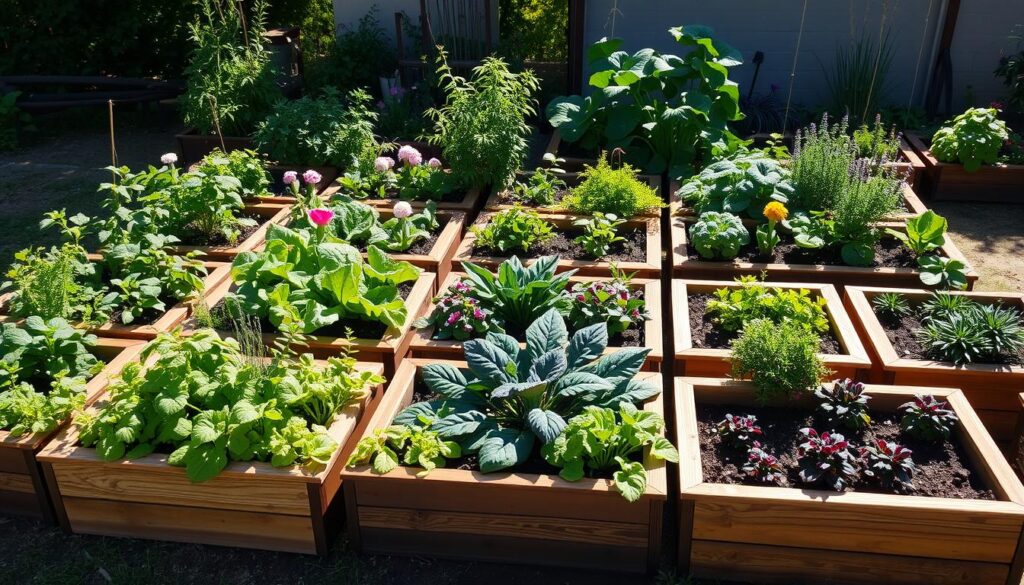
There are several ways to create your grid. You can use wood lathe, string, or invest in a Garden Grid™ system. Each method has its benefits, so choose one that fits your style and budget.
Consider crop rotation within your squares to maintain soil health. Pairing compatible vegetables through companion planting can also boost growth and deter pests. For example, tomatoes and basil thrive together, while carrots and onions make great neighbors.
Height-based placement is another smart strategy. Place taller plants on the north side to avoid shading smaller ones. Use vertical space for climbers like beans or cucumbers to save ground area.
Succession planting keeps your bed productive throughout the season. After harvesting early crops like lettuce, replant with warm-season varieties like peppers. This ensures a continuous supply of fresh produce.
Get creative with theme gardens! A salsa garden could include tomatoes, peppers, and cilantro, while a salad garden might feature lettuce, radishes, and cucumbers. These themed setups make planning and harvesting more enjoyable.
Visual planning tools can simplify the process. Use color-coding to map out your grid or try digital apps for a modern approach. If you prefer a hands-on method, hand-drawn sketches work just as well.
Understanding Plant Spacing in Square Foot Gardening
Getting the right spacing for your plants is essential for a thriving setup. Proper placement ensures each plant has enough room to grow, access to nutrients, and adequate sunlight. This method uses a simple formula to determine how many plants per square foot you can grow.
The formula is: (12 ÷ spacing inches)² = plants/sq ft. For example, if your plants need 3 inches of space, you can grow 16 plants in one square foot. This calculation helps you maximize your area without overcrowding.
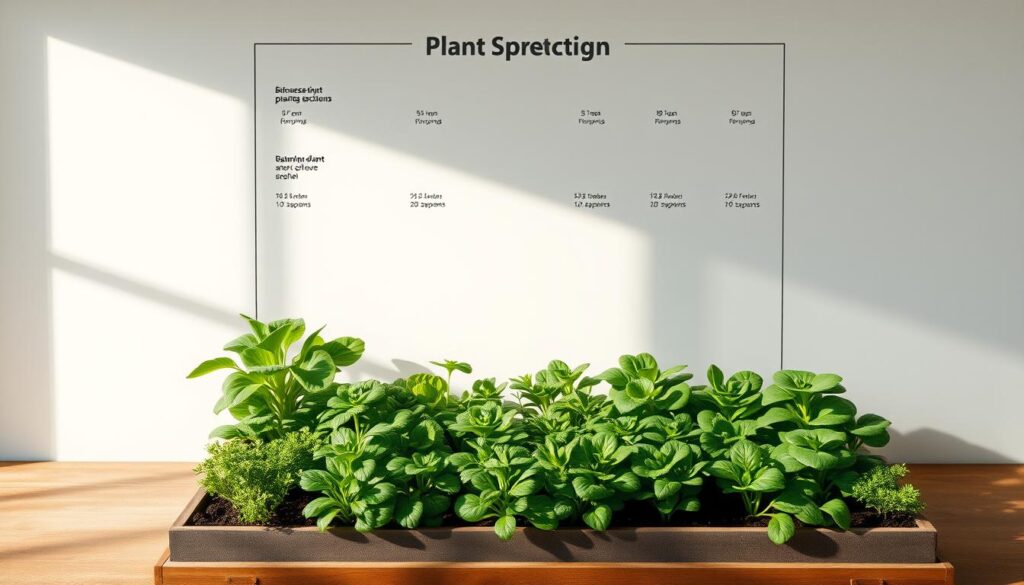
Seed packets often provide spacing recommendations. Use these as a starting point, but adjust based on the mature size of your plants. Larger vegetables like tomatoes may need more room, while smaller ones like radishes can be planted closer together.
Special cases, such as vining plants or root crops, require unique approaches. Vining plants can be trained vertically to save space, while root crops need deeper soil for proper growth. Microgreens are an exception, as they can be densely packed for quick harvests.
Tools like Seed Spacer templates or dibbers can simplify the process. These help you measure and mark the exact spots for planting, ensuring consistency across your setup. Avoid common mistakes like overcrowding or ignoring plant size adjustments.
By following this guide, you’ll create a balanced and productive growing area. Proper spacing leads to healthier plants and higher yields, making your gardening experience more rewarding.
Using a Square Foot Garden Planting Chart
Planning your growing space just got easier with a detailed planting guide. A chart helps you organize your setup, ensuring each plant has the right amount of room to thrive. Whether you’re growing herbs, flowers, or vegetables, this tool simplifies the process.
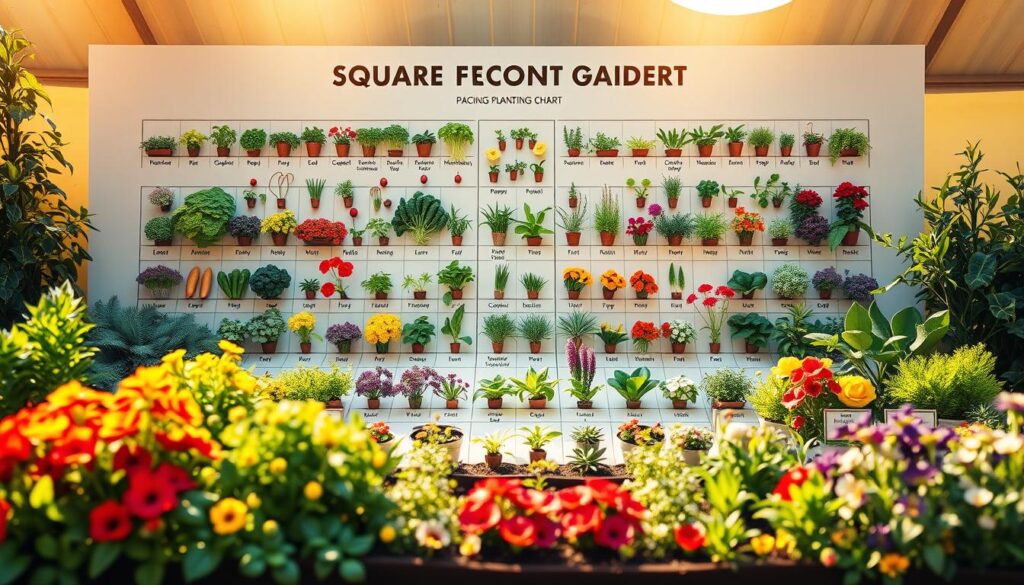
- Planting Density Codes: Learn how many plants per square to grow based on their size and spacing needs.
- Seasonal Adjustments: Adapt your plan for spring, summer, and fall crops to keep your bed productive year-round.
- Succession Planting: Replace harvested crops with new ones to maximize yields.
- Companion Planting: Pair compatible plants to boost growth and deter pests naturally.
- Soil Depth Requirements: Ensure each plant has the right soil depth for healthy root development.
- Sunlight Needs: Match plants with their ideal light conditions for optimal growth.
- Yield Estimates: Plan for preserving or freezing your harvest with realistic yield predictions.
Many guides include over 60 plant varieties, making it easy to customize your setup. Downloadable PDFs and templates are available for added convenience. For more tips on starting your growing journey, check out our comprehensive guide.
Step-by-Step Guide to Planting in a Square Foot Garden
Ready to turn your growing area into a productive oasis? Follow these simple steps to prepare your soil and plant your seeds or seedlings for a thriving setup.
Preparing the Soil
Start by testing your soil to ensure it has the right nutrients. A balanced mix of compost, peat moss, and vermiculite works best. Combine them in equal parts for optimal results.
Amend your soil regularly, especially if you’re growing continuous crops. This keeps it fertile and ready for each new planting cycle. Labeling each square in your bed helps you track amendments and crop rotations.

Planting Your Seeds or Seedlings
When it’s time to plant, follow the recommended seed depth for each variety. A general rule is to plant 2-3 seeds per hole to ensure germination. Thin them later if needed.
For seedlings, use the hardening-off process. Gradually expose them to outdoor conditions before transplanting. This reduces shock and helps them adapt faster.
Proper spacing is crucial. Overcrowding can lead to competition for resources, while too much space wastes valuable area. Water your plants immediately after planting to settle the soil around the roots.
If germination issues arise, check the moisture level and temperature. Most seeds need warmth and consistent moisture to sprout. Troubleshoot by adjusting these factors as needed.
Maintaining Your Square Foot Garden
Keeping your growing area in top shape doesn’t have to be time-consuming. With just 15 minutes daily and an hour weekly, you can ensure your plants thrive. Regular care helps you make the most of your space and enjoy a bountiful harvest.
Start with a daily inspection checklist. Look for signs of pests, wilting, or overgrowth. Early detection prevents bigger problems later. A drip irrigation system keeps your bed hydrated without wasting water. Check for clogs or leaks to ensure it works efficiently.
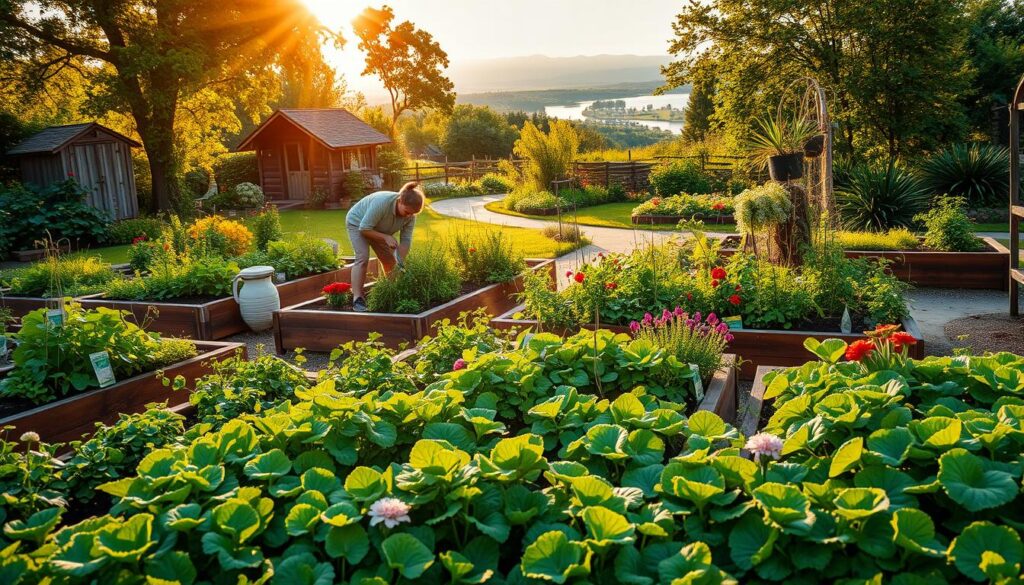
Organic pest control is a must for healthy vegetables. Use natural recipes like neem oil or garlic spray to deter pests without harmful chemicals. Companion planting also helps by attracting beneficial insects.
Succession planting keeps your space productive. After harvesting one crop, replant with a new variety. This ensures a continuous supply of fresh produce throughout the season.
Seasonal protection is crucial for year-round gardening. Use row covers or cold frames to shield your plants from frost. In summer, shade cloth prevents overheating.
Refresh your soil regularly to maintain its fertility. Add compost or organic matter to replenish nutrients. Rotate crops to prevent soil depletion and reduce disease risks.
Harvest rotation ensures even growth. Pick mature vegetables first to make room for younger ones. This keeps your bed balanced and productive.
| Task | Frequency | Details |
|---|---|---|
| Inspection | Daily | Check for pests, wilting, and overgrowth. |
| Irrigation | Weekly | Inspect drip system for clogs or leaks. |
| Pest Control | As Needed | Use organic sprays or companion planting. |
| Soil Refresh | Monthly | Add compost or organic matter. |
| Seasonal Protection | Seasonal | Use row covers or shade cloth. |
Maximizing Yields in a Square Foot Garden
Boost your harvest with smart strategies for small spaces. By using innovative techniques, you can grow more vegetables in less space. Whether you’re a beginner or an experienced grower, these tips will help you get the most out of your setup.
One effective method is interplanting. Pairing compatible plants like radishes and carrots maximizes your area. Radishes grow quickly and are harvested before carrots need the room. This approach ensures continuous growth and higher yields.
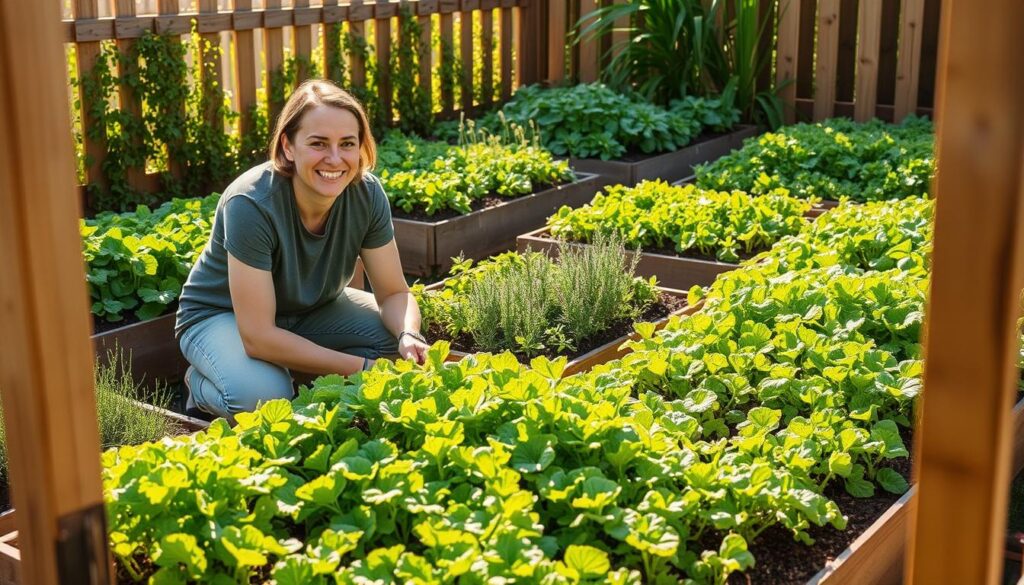
Vertical growing is another game-changer. Structures like trellises or cages allow vining vegetables like cucumbers to grow upward. This can yield up to 10 pounds per square foot, saving ground space for other crops.
Extend your growing season with hoop houses or cold frames. These protect your garden from frost, allowing you to grow longer into the fall or start earlier in the spring. It’s a simple way to increase your harvest window.
Here are more tips to maximize your yields:
- Intensive intercropping: Combine plants with different growth rates and nutrient needs.
- DIY vertical structures: Build trellises or cages to save space.
- Fertilizer tea: Use organic recipes to nourish your plants naturally.
- Pollinator attraction: Plant flowers to attract bees and boost pollination.
- Fruit-thinning: Remove excess fruit to improve size and quality.
- Succession planting: Replace harvested crops with new ones for continuous growth.
By implementing these strategies, you’ll create a productive and efficient growing area. With a little planning, you can enjoy a bountiful harvest all season long.
Common Mistakes to Avoid in Square Foot Gardening
Avoiding common pitfalls can make your gardening journey smoother and more productive. Even small errors can lead to big problems, so it’s essential to know what to watch out for. Here are the most frequent mistakes and how to prevent them.
Overcrowding is a top issue, with 73% of failures linked to it. Planting too many plants in one area limits their access to nutrients and sunlight. Always follow recommended spacing guidelines to ensure healthy growth.
Poor soil quality is another major concern, accounting for 68% of problems. Regularly test and amend your soil with compost or organic matter. This keeps it fertile and ready for each planting cycle.
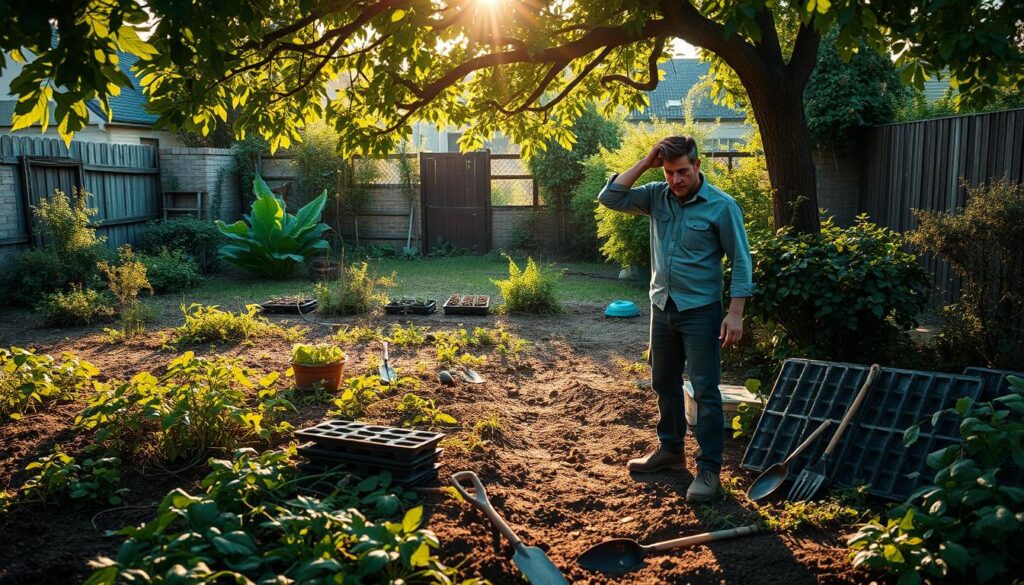
Incorrect plant height placement affects 55% of setups. Taller plants should be placed on the north side of your bed to avoid shading smaller ones. This simple adjustment can make a big difference.
Here are more mistakes to avoid:
- Trellis weight limits: Ensure your trellises can support the weight of vining plants like cucumbers or beans.
- Watering system pitfalls: Overwatering or underwatering can harm your plants. Use a drip irrigation system for consistent moisture.
- Crop rotation myths: Rotate crops to prevent soil depletion and reduce disease risks. Don’t skip this step!
- Pest prevention oversights: Regularly inspect your garden for pests and use organic solutions like neem oil.
- Harvest timing errors: Pick produce at the right time to ensure the best flavor and encourage continuous growth.
By avoiding these mistakes, you’ll create a thriving and productive growing space. A little planning and attention go a long way in ensuring your garden flourishes.
Conclusion
Transform your small space into a thriving oasis with these simple tips. Square foot gardening maximizes efficiency, making it perfect for beginners and urban dwellers. With a printable chart, you can easily plan your setup and enjoy higher yields.
This method isn’t just for individual use. Community gardens and children’s education programs benefit greatly from its simplicity. Teaching kids to grow their own plants fosters a love for nature and sustainability. Did you know this approach can reduce water usage by up to 50%?
Ready to take the next step? Explore the Garden Grid™ system for an even more organized and productive experience. Start your journey today and see how easy it is to grow more in less space!

